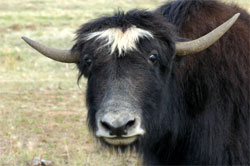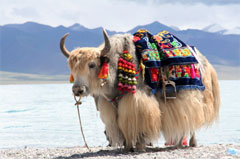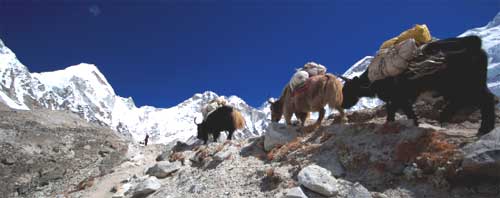|

 A Real Yak: Wild yaks (subspecies B. g. mutus) stand about two meters tall at the shoulder and weigh 1,000 kg (2,200 lb). They usually form groups of between 10 and 30 animals. Domestic yaks are about half that height, usually weighing over 1200 pounds with a lifespan of 20-25 years. Both types have long shaggy hair to insulate them from the cold. Wild yaks can be either brown or black. Domesticated ones can also be white. Both males and females have horns. The word Yak is also used to describe an irritating or disagreeable individual. A Real Yak: Wild yaks (subspecies B. g. mutus) stand about two meters tall at the shoulder and weigh 1,000 kg (2,200 lb). They usually form groups of between 10 and 30 animals. Domestic yaks are about half that height, usually weighing over 1200 pounds with a lifespan of 20-25 years. Both types have long shaggy hair to insulate them from the cold. Wild yaks can be either brown or black. Domesticated ones can also be white. Both males and females have horns. The word Yak is also used to describe an irritating or disagreeable individual.

 A Nice Breeze: Wild yaks inhabit treeless uplands like hills, mountains and plateaux between 3,200 m (10,500 ft) and roughly 5,400 m (18,000 ft). They eat grasses, lichens and other plants. During the warmest season these hardy animals live in areas of permanent snow and move lower down at colder times. They are insulated by dense, close, matted under-hair as well as their shaggy outer hair. A Nice Breeze: Wild yaks inhabit treeless uplands like hills, mountains and plateaux between 3,200 m (10,500 ft) and roughly 5,400 m (18,000 ft). They eat grasses, lichens and other plants. During the warmest season these hardy animals live in areas of permanent snow and move lower down at colder times. They are insulated by dense, close, matted under-hair as well as their shaggy outer hair.
Possible Advertisement
Beasts of Burden: Domesticated yaks are kept primarily for their milk, fiber, and meat; they are also used as beasts of burden, transporting goods across mountain passes for local farmers and traders as well as in support of climbing and trekking expeditions. Yak milk is often processed to a cheese called chhurpi in Tibetan and Nepali languages, and byaslag in Mongolia. Often the pack animals are actually crossbreeds of the yak and Bos taurus (common domestic cattle). These are known in Tibetan as dzo or dzopkyo.

Sewing Machines: Yak fiber is soft and smooth, in several colors, including shades of gray, brown, black and white. The length of yak fiber is about 1.2 inches. It is combed or shed from the yak and then dehaired. The result is a splendid downy fiber that can be spun into yarn for knitting.
Unlike cattle, yaks grunt rather than moo. Many wild yaks are killed for food by the Tibetans; they are now an endangered species.
More recently, sports involving domesticated yaks, such as yak skiing or yak polo, are being marketed as tourist attractions in Central Asian countries.
All text is available under the terms
of the GNU Free Documentation License
|